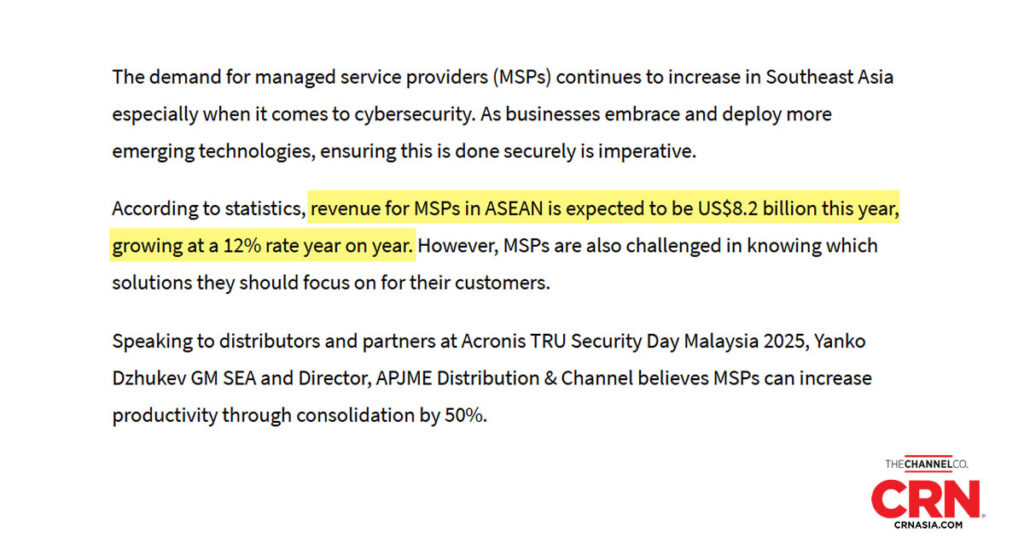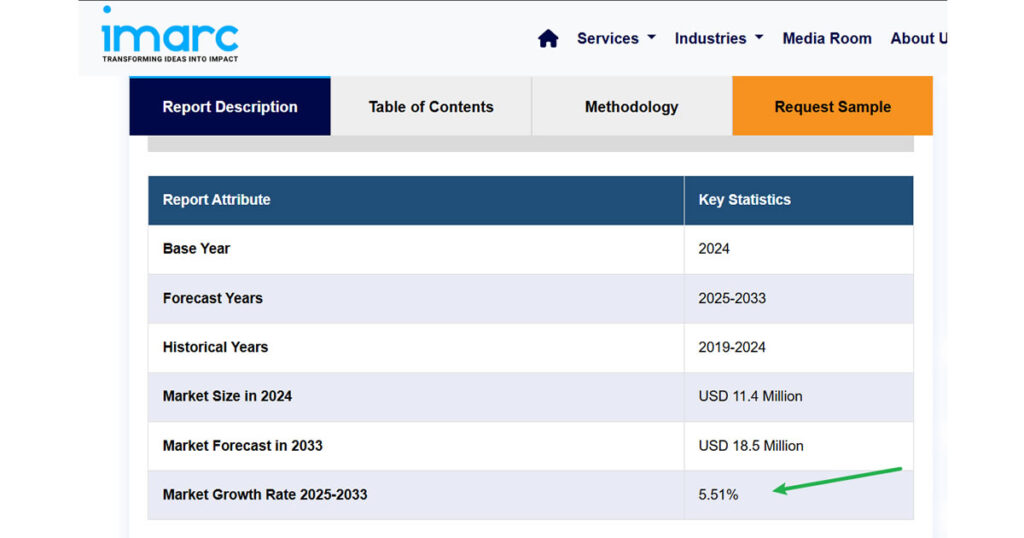The first 90 days with a managed IT partner are more than just an orientation period. They set the foundation for trust, stability, and long-term results. In our experience, businesses that approach onboarding as a structured process often see smoother operations, faster ROI, and stronger security outcomes compared to those who treat it as a formality.
The trend is clear in our region. According to CRN Asia, the managed services market in ASEAN is projected to reach USD 8.2 billion by 2025, growing at around 12% year on year. Yanko Dzhukev, Director of APJ ME Distribution & Channel and General Manager for Southeast Asia, notes that opportunities for managed service providers will continue to expand across the region. Together, these signals point to two realities: more organizations are outsourcing IT to improve efficiency, and expectations for partners to deliver measurable results early are higher than ever.
If you are considering bringing a managed IT partner on board, it’s important to understand what the onboarding journey looks like. Those early onboarding stages are where expectations are set, systems are stabilized, and the groundwork is laid for long-term collaboration.
In this article, we will down what you can expect across the first 90 days of working with a managed IT partner, from preparation before kickoff to the stabilization and optimization phases that follow.

Pre-Kickoff Preparations (Before Day 1)
Onboarding technically begins before the first official meeting. A capable managed IT partner supports, troubleshoots, and manages IT systems by first understanding your current environment. This pre-kickoff stage ensures there are no surprises once work begins.
Key activities include:
- Discovery and audits: Mapping existing infrastructure, network topologies, and system dependencies.
- Documentation gathering: Collecting credentials, policies, and prior incident logs to establish a baseline.
- Stakeholder mapping: Identifying key decision-makers, IT staff, and department heads who will be involved in the transition.
- Expectation setting: Clarifying what “success” in the first 90 days looks like, from uptime goals to faster ticket resolution times.
In Malaysia, many organizations still run hybrid environments, with cloud applications sitting on top of older servers or branch-office systems. This mix makes discovery and documentation even more important, as hidden gaps can later cause delays.
Once pre-kickoff activities are complete, the project moves naturally into the first formal phase: laying the foundation and stabilizing operations during the initial 30 days.
Days 1–30: Foundation & Stabilization
The first month is about establishing control and stability. This is where the partner demonstrates their ability to manage, optimize, and troubleshoot effectively.
You can expect the following steps:
- Kickoff meeting: Aligning all stakeholders on timelines, responsibilities, and escalation paths.
- Baseline assessments: Running diagnostics across network monitoring, server health, and endpoint protection. This helps identify vulnerabilities and areas for immediate remediation.
- Quick wins: Addressing obvious risks such as unpatched systems, misconfigured firewalls, or outdated antivirus software.
- Tool deployment: Introducing monitoring dashboards and ticketing systems so issues can be tracked and resolved transparently.
The regional market context reinforces why this foundation matters. IMARC forecasts that the South-East Asia managed services market will continue strong growth through 2033 (see screenshot below), with more organizations demanding proactive, metrics-driven service delivery. In other words, laying a structured foundation in the first 30 days is what your peers and competitors are already doing to stay ahead.

With the groundwork in place, the next phase — Days 31 to 60 — focuses on deeper integration and bringing employees into the journey.
Days 31–60: Deployment, Integration & Training
With the groundwork set in the first month, the next 30 days focus on rolling out tools, integrating systems, and preparing employees. This stage is where your managed IT partner begins to demonstrate real impact across day-to-day operations.
Typical activities include:
- Monitoring and management tools: Network monitoring solutions are deployed to track uptime, alert on anomalies, and report on performance.
- Security enhancements: Endpoint protection and email security filters are configured to detect and isolate threats before they disrupt users.
- Application and system integration: Connecting cloud storage, backup solutions, or ERP systems so workflows run without disruption.
- Employee onboarding and training: Ensuring staff know how to use the new systems, log tickets, and access support.
A strong real-world example comes from Malaysia Airlines, which partnered with Tata Consultancy Services (TCS) to transform its IT operations (read the case study here). By introducing structured service management and better reporting, TCS completed the project three months ahead of schedule. This case shows how disciplined onboarding and integration can accelerate improvements rather than slow them down.

The 31–60 day period is also when feedback loops become critical. From our experience, this is the stage where employees begin to use the new systems daily, uncovering small issues that might not have surfaced during testing. Managers start to see performance dashboards and support reports, giving them visibility they may not have had before.
At Callnet Solution, we view this phase as a two-way learning process. Our team refines the support model based on actual user behavior, while your staff gain confidence in knowing that issues are logged, tracked, and resolved transparently. With training and feedback aligned, the organization is well-prepared for the final stage of onboarding: optimization and steady-state operations.
Days 61–90: Optimization, Handover & Operational Rhythm
By the third month, most of the heavy lifting should already be behind you. Systems are stabilized, monitoring tools are fully active, and employees are more familiar with the workflows introduced during onboarding. From our perspective, this is where the real partnership begins.
The focus shifts away from “fixing” toward fine-tuning performance. It’s also the point where we formalize the operating rhythm with our clients: regular reporting, governance reviews, and clear escalation paths that ensure IT is no longer a pain point, but a growth enabler.
You can expect three main activities during this period:
- Performance optimization: Adjusting configurations for servers, network, and cloud resources to balance cost and performance.
- SLA and KPI reporting: Baseline metrics such as uptime, incident response times, and support ticket trends are tracked and reported.
- Governance review and handover: Reviewing goals set at kickoff, confirming alignment, and transitioning into steady-state operations.
At this stage, your managed IT partner should be providing clear evidence of improvement, whether that’s reduced downtime, faster support response, or more predictable costs. The goal is to reach a point where IT operations feel seamless and the business has confidence in its technology foundation.
This optimization phase also sets the stage for continuous improvement. A partner that manages, troubleshoots, and optimizes on an ongoing basisensures the business stays resilient against new challenges like ransomware or regulatory changes.
Metrics & KPIs to Watch in the First 90 Days

Getting onboard is not about installing tools, or setting up servers, or handing over passwords. It is about building trust from day one. The first 90 days are where we prove that IT can support business goals, reduce operation headaches, and create measurable value for our clients’ businesses.
Alan Leong
CallNet Solution Technical Director
At Callnet Solution, we believe that a structured onboarding is only successful if it produces measurable results. You should not just feel that things are better but to be able to see improvements in the data. That’s why we emphasize clear metrics from day one. Tracking uptime, response times, ticket volumes, and user satisfaction gives both sides a shared view of progress. These KPIs provide transparency, build trust, and confirm whether the partnership is on the right path (or if further adjustments are needed).
- System uptime and availability: Fewer outages mean stronger operational stability.
- Incident response times vs SLA: Tickets should be acknowledged and resolved within agreed timelines.
- Ticket volumes and patterns: Ideally, the number of recurring issues decreases after stabilization.
- User satisfaction scores: Employee surveys help measure whether new systems are usable and support is responsive.
- Adoption rates of new tools: High adoption indicates effective training and integration.
By paying attention to KPIs in the first 90 days, businesses gain clarity on whether the partnership is truly delivering value and where adjustments may be needed.
Challenges in Malaysia / SEA (and How to Mitigate)
Even with the best planning, onboarding in Malaysia and the wider SEA region often comes with unique challenges. Very often these obstacles not as roadblocks but as opportunities to apply the right tools and expertise.
Legacy systems still in use
Many enterprises run on a mix of older on-premise servers and newer cloud applications. This hybrid creates complexity during onboarding. To address this, we often rely on partners like Dell and HP Enterprise, whose server solutions scale and stabilize legacy infrastructure while allowing room for modernization.
Compliance and governance pressures
Different industries, from finance to retail to manufacturing, face varied regulatory requirements. Onboarding is the right time to align systems with those frameworks, whether that means strengthening access controls, tightening audit trails, or ensuring data is stored in compliant environments.
Disaster recovery expectations
In a region where cyberattacks and outages are growing risks, companies demand assurance that recovery is fast and reliable. Our onboarding process includes validating recovery objectives and testing failover procedures so that resilience isn’t left to chance. Veeam’s disaster recovery tools, for instance, allow us to restore critical systems quickly, minimizing downtime and safeguarding operations.
Change resistance among staff
Employees are often cautious about new systems or fear added complexity. We approach this by combining phased rollouts with hands-on training, ensuring adoption feels smooth rather than forced. Over time, staff see that the changes reduce, not increase, their daily frustrations.
In our experience, it’s not the technology alone that makes onboarding successful. Rather, it’s the combination of the right tools, practical training, and ongoing support that helps organizations overcome these challenges.
Wrapping Up
The first 90 days with a managed IT partner are decisive. From pre-kickoff preparation to stabilization, integration, and optimization, every phase builds toward a stable and productive partnership. At Callnet Solution, we support, troubleshoot, and optimize IT environments with a structured onboarding process designed specifically for Malaysian enterprises.
Our partner ecosystem — from Dell and HP to Cisco, Microsoft, Druva, Alibaba Cloud, AWS, Sangfor, and Veeam — allows us to meet different scenarios and budgets without compromise.
If you are preparing to bring a managed IT partner on board, the key is knowing what to expect in those early stages. Done well, onboarding is not just a transition period. It will be the moment where IT becomes a driver of resilience and growth for your company.
Ready to see what a structured onboarding journey looks like? Learn more on our Managed IT Services.



